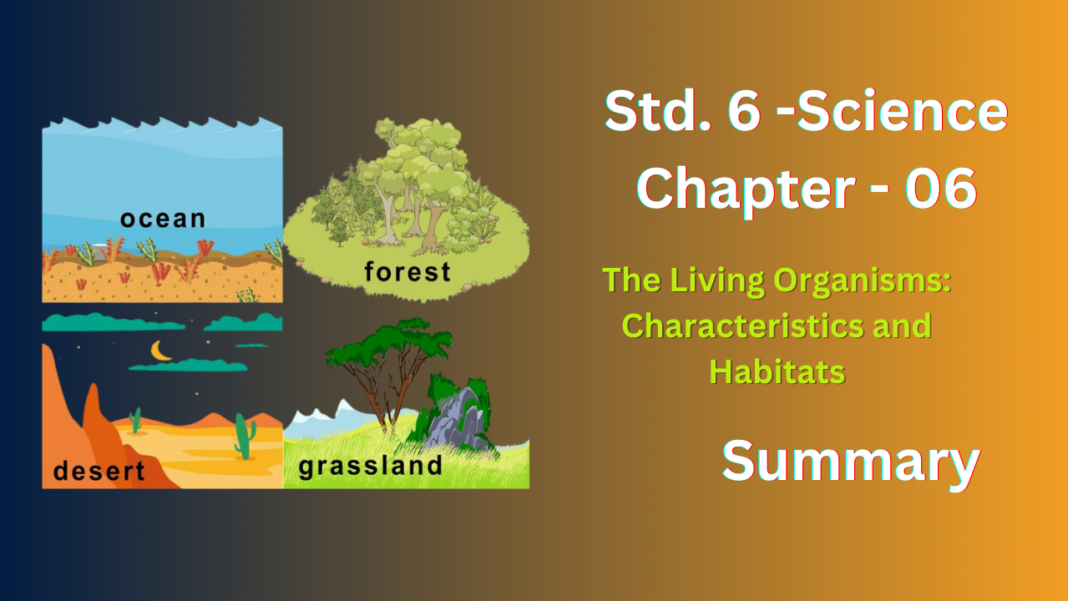NCERT Solutions for Class 6 Science Chapter 6 : The living organism characteristics and habitats
NCERT Solutions for Class 6 Science Chapter 6 The Living Organisms Characteristics and Habitats focuses on the key characteristics that distinguish living organisms from non-living things and explores the diverse habitats these organisms inhabit.
Characteristics of Living Organisms: NCERT Solutions for Class 6 Science Chapter 6
Made of cells: All living things are composed of tiny units called cells, which are the basic building blocks of life.
Obtain and use energy: Living organisms require energy to carry out various life functions like growth, movement, and reproduction. They obtain energy from their environment through various means, like plants using sunlight through photosynthesis and animals consuming food.
Grow and develop: Living organisms exhibit growth, increasing in size and complexity over time. They also undergo development, changing form and function as they mature.
Reproduce: Living things have the ability to reproduce, creating new individuals of their kind. This can occur through various methods like sexual reproduction (involving two parents) or asexual reproduction (involving a single parent).
Adapt to their environment: Living organisms can adapt to changes in their environment over time. This can happen through inherited traits passed down through generations or individual adaptations within an organism’s lifetime.
Respond to their environment: Living organisms can sense and respond to stimuli in their environment, allowing them to interact with their surroundings and survive.
Habitats and Adaptations:
Habitat: The natural environment where an organism lives and finds the resources it needs to survive and reproduce. Different types of habitats exist, such as forests, grasslands, deserts, oceans, and freshwater ecosystems.
Adaptation: The specific characteristics or behaviors that enable an organism to survive and thrive in its specific habitat. Examples of adaptations include physical features like camouflage or specialized body parts, as well as behavioral adaptations like migration or hibernation.
NCERT Solutions for Class 6 Science Chapter 6
Exercises
1. What is a habitat?
Ans : The natural environment in which an organism lives and finds the resources it needs to survive and reproduce.
2. How are cactus adapted to survive in a desert?
Ans : Cacti have developed several unique adaptations that enable them to thrive in the harsh desert environment, characterized by extreme temperatures, scarce water, and intense sunlight. Here are some key adaptations:
1. Reduced water loss:
- Spines or thorns: These replace leaves, minimizing the surface area for transpiration, the process by which plants lose water vapor through their leaves.
- Waxy coating: A waxy layer on the stem further reduces water loss by acting as a barrier against evaporation.
- Shallow root systems: These roots spread widely near the surface to absorb any available water from infrequent rainfall events.
2. Water storage:
- Fleshy stems: Cacti have thick, fleshy stems that store large amounts of water, acting like a reservoir during dry periods. The water content can vary depending on the cactus species and environmental conditions.
3. Fill up the blanks (NCERT Solutions for Class 6 Science Chapter 6)
(a) The presence of specific features, which enable a plant or an animal to live
in a particular habitat, is called_____
(b) The habitats of the plants and animals that live on land are called_____habitat.
(c) The habitats of plants and animals that live in water are called_____habitat.
(d) Soil, water and air are the_____factors of a habitat.
(e) Changes in our surroundings that make us respond to them, are called_____
Ans : (a) Adaptation.
(b) Terrestrial
(c) Aquatic
(d) Non-living
(e)Stimuli.
4. Which of the things in the following list are nonliving?
Plough, Mushroom, Sewing machine, Radio, Boat, Water hyacinth, Earthworm
Ans :
- Plough
- Sewing machine
- Radio
- Boat
5. Give an example of a non-living thing, which shows any two characteristics of living things.
Ans: A crystal
- Growth: Crystals can appear to grow over time, adding layers and increasing in size. However, this is due to the accumulation of new material from the surrounding environment, not through biological processes like cell division in living things.
- Reaction to stimuli: Some crystals exhibit piezoelectricity, meaning they can generate a small electric current when pressure is applied. While this might seem like a response to a stimulus, it’s a physical phenomenon based on the crystal’s structure and not a conscious or biological response like in living things.
6. Which of the non-living things listed below, were once part of a living thing? Butter, Leather, Soil, Wool, Electric bulb, Cooking oil, Salt, Apple, Rubber
Ans:
- Butter: Made from churning milk, which comes from cows.
- Leather: Obtained from the skin of animals.
- Wool: Fibers from the fleece of sheep or other animals.
- Cooking oil: Extracted from the seeds or fruits of plants.
- Apple: A fruit that grows on an apple tree.
- Rubber: Derived from the latex of rubber trees.
7. List the common characteristics of the living things.
Ans :
- Cellular organization: All living things are composed of cells, which are the basic units of life. These cells carry out essential functions like growth, reproduction, and metabolism.
- Growth and development: Living things exhibit growth, increasing in size and complexity over time. They also undergo development, changing form and function as they mature.
- Reproduction: Living things have the ability to reproduce, creating new individuals of their own kind. This can happen through various methods, such as sexual reproduction (involving two parents) or asexual reproduction (involving a single parent).
- Metabolism: Living things require energy to carry out their various life functions. They obtain this energy through various methods, such as plants using sunlight through photosynthesis and animals consuming food. This process of transforming energy and materials for growth and repair is called metabolism.
- Homeostasis: Living things maintain a stable internal environment despite changes in the external environment. This process of maintaining a constant internal state is called homeostasis.
8. Explain, why speed is important for survival in the grasslands for animals that live there. (Hint: There are few trees or places for animals to hide in grasslands habitats.)
Ans :Speed is crucial for survival in the grasslands for several reasons related to the lack of trees and hiding places:
- Predator evasion: Grasslands are open habitats with few trees or dense vegetation for animals to hide from predators like lions, tigers, and cheetahs. Prey animals, like zebras and gazelles, must rely on their speed to outrun these predators and escape being hunted.
- Hunting success: Predators in the grasslands also rely on speed to catch their prey. Lions and cheetahs use bursts of speed to chase down and capture grazing animals.
- Open terrain: The wide-open spaces of grasslands mean animals are easily visible to both predators and prey alike. Without natural cover, both predator and prey need to rely on speed for either successful hunting or quick escapes.
- Resource competition: In some cases, speed might also be important in reaching food and water sources before other animals in the grassland ecosystem.
NCERT Solutions for Class 6 Science Chapter 6 : The living organism characteristics and habitats
FAQ’s
What topics are covered in NCERT Solutions for Class 6 Science Chapter 6?
Chapter 6 of Class 6 Science covers various aspects of living organisms, including their characteristics and habitats.
How do NCERT Solutions for Class 6 Science Chapter 6 help in understanding living organisms?
These solutions provide detailed explanations and examples to help students understand the characteristics that define living organisms and how they adapt to different habitats.
What are some key characteristics of living organisms discussed in NCERT Solutions for Class 6 Science Chapter 6?
Characteristics include growth, reproduction, response to stimuli, metabolism, and organization.
How are different habitats classified in NCERT Solutions for Class 6 Science Chapter 6?
Habitats are classified based on their physical features, climate, and the types of organisms that live in them. Examples include terrestrial, aquatic, desert, and forest habitats.
Are there any real-life examples or case studies provided in NCERT Solutions for Class 6 Science Chapter 6 to understand living organisms and their habitats better?
Yes, NCERT Solutions for Class 6 Science Chapter 6 the solutions may include examples of different organisms found in various habitats, their adaptations to survive in those habitats, and the interdependence of living organisms within ecosystems.









